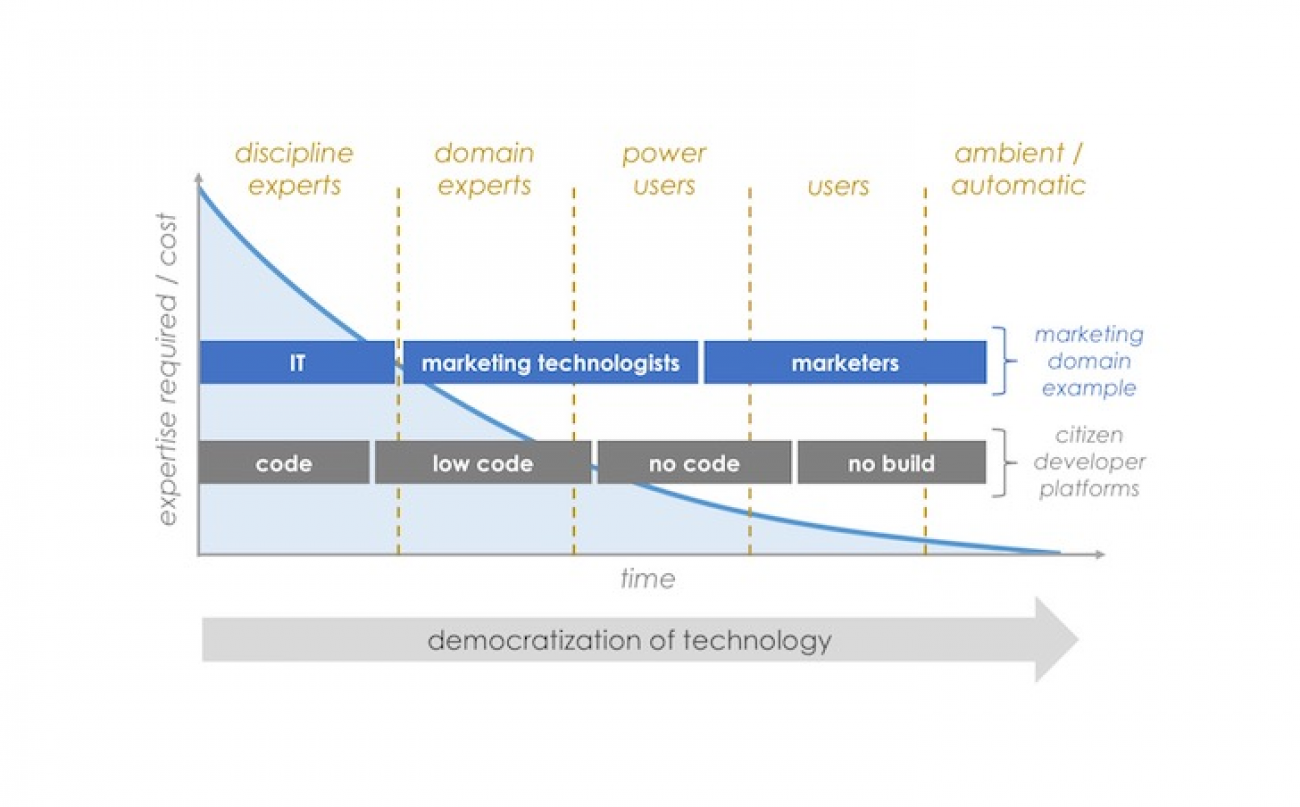Scott Brinker's vision of low code.

By Craig Hanna
14th Nov 2018
Having just attended the young up-coming anti-conference Martech festival, I have had the pleasure to both listen to and then meet the appointed godfather of martech Scott Brinker. If you have not visited his site or attended one of his talks, I strongly recommend you give it a go. His vision of the industry over the years has been consistently accurate and the insights he provides are of material use.
One of the areas of particular interest to us here at Cohesion is the progression in the industry of the low-code movement. Although we all have heard of this revolution, Scott demonstrates the ‘beyond’ which is particularly interesting. Below is the illustration he uses to demonstrate this point.

© Scott Brinker
Here Scott has highlighted several key phases of this progression and how the movement away from traditional code opens up new opportunities to business. In his recent article, Now every marketer is an app developer, he explores how this has transformed marketeers and their function within a business.
So how does this sit with Cohesion DX8 and its approach to Drupal 8? Depending on the audience using our product, DX8 sits in multiple parts of this model.
Designer/developer - DX8 as a low code and no code platform
DX8 provides an interface to allow an individual with an understanding of CSS and HTML to undertake the styling, build and theming of the site through our low-code interface. We deliberately do not try to emulate some of the alternative industry solutions where a visual representation of what the user wants to achieve is automatically converted to CSS/HTML. This approach is limiting and often messy. Instead, we provide a low-code interface to allow the coder to access the CSS/HTML.
However, we quickly move into no-code when we start taking advantage of DX8’s ability to integrate layout and styles into the Drupal ecosystem. To give you a perspective on what this means to the individual, the skill sets required to achieve this (ignoring bespoke advanced functionality) look like the following:
Knowledge of:
- CSS
- Responsive HTML, responsive grid systems and flexbox
- Awareness of Drupal 8 and its general approach to site creation
What this individual does not need to be aware of includes:
- Structuring code / best practice
- Understanding Drupal theming from a code perspective
- Drupal 8 file systems
- TWIG code format
- Paragraphs or equivalent to provide the editing experience
By moving the theming from the discipline of the Drupal Expert to that of a CSS/HTML-aware coder, the benefits are significant including:
- Training reduced from several months to several days
- Removal of the requirement for high-end skill sets to perform general tasks
- Reduction of handover points results in greater efficiency
- Minimal code degradation
- Opportunity for multiple compilations of code for separate use cases - e.g. headless, AMP, react etc.
Marketer - DX8 as a no code platform
However, when we focus on the marketeers, we move firmly into the no-code and no-build segments. DX8 allows the site builders to create what are essentially the building blocks of websites including the components needed to achieve great UX. If configured correctly, here are just a few examples of what a marketer can now achieve using DX8:
- Implement an advanced UX-based A/B testing programme
- One click creation of a new, branded website
- ‘Drag and drop’ landing page creation without any pre-built custom coding
This brings unparalleled agility within the Enterprise space to marketeers.
For example, with a HubSpot pre-built distribution, a marketer could spin up a fully CRM-integrated campaign site with a bespoke user experience and launch within a day. We feel this is the organisational empowerment that Scott envisages.
Content editors - DX8 as a no-build platform
Finally, with DX8 content editors can be given more control of the editorial experience but within the guard rails provided by the design and development team. This control is crucial as “storytelling” and “experiential content” become increasingly important to brands wanting to cut through the current climate of content saturation and stand out from their competitors.
An example of this in action in DX8 is our helpers, which enable content editors to choose from a range of pre-built page layouts, depending on the content they have available, which they simply drag and drop onto the page to get a fully tested, fully editable page. Just add the content and publish. No code, no build.
The future of enterprise web builds
Our vision of the future very much aligns with Scott's. In fact, we’re already well down this path with the features and tools already available in DX8. To borrow the infamous quote from William Gibson:
The [low-code] future is already here – it's just not evenly distributed.
William Gibson - Novelist
About the author.

Craig Hanna, Sales and Marketing Director
Craig leads Sales and Marketing at Cohesion and is a regular keynote speaker across Europe and US on a range of topics from marketing to digital transformation. Craig has over 15 years of experience across the digital sector and has worked with DuPont, L'Oreal, KPMG, British Airways and Vodafone among many others.

By Craig Hanna
14th Nov 2018
Experience
Get a demo and try Acquia Cohesion.
Request a personalized demo and sandbox to test drive Acquia Cohesion for yourself.
Get a demo